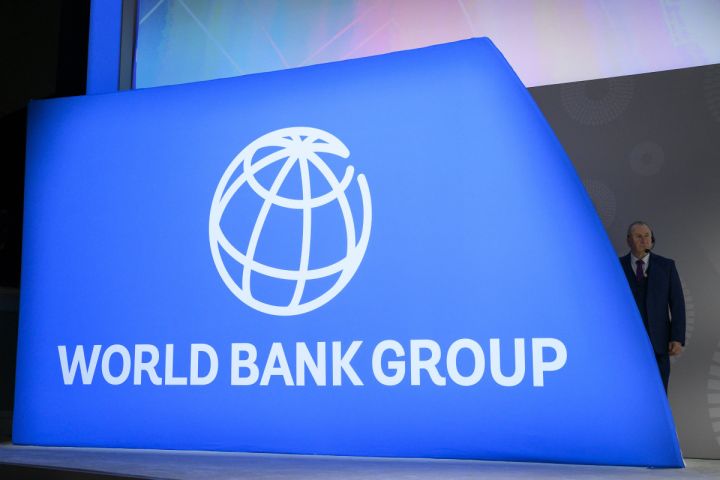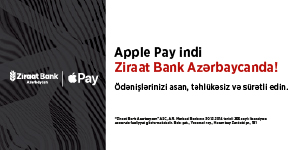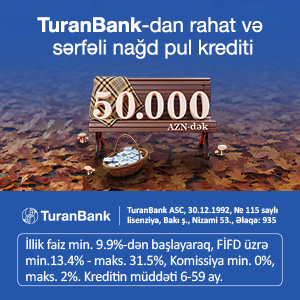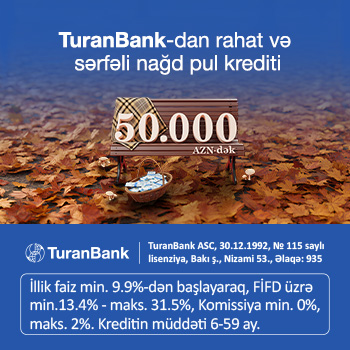"Xaricdən Azərbaycana pul axını tədricən artacaq"

“Azərbaycanda maliyyə sisteminin zəif olmasına baxmayaraq, iqtisadi artımın sürətlənməsi ilə sistemin də tədricən güclənəcəyini proqnozlaşdırırıq”.
Bu barədə “Standard&Poor’s” beynəlxalq reytinq agentliyinin Azərbaycanın suveren kredit reytinqi ilə bağlı yaydığı məlumatda qeyd olunub.
Hesabatın müəllifləri bank sisteminə nəzarət sahəsindəki son inkişafı da yüksək qiymətləndirir. “Maliyyə Bazarlarına Nəzarət Palatası yaradılıb və bank risklərinə nəzarətlə məşğuldur. Azərbaycanın xarici mövqeyi də güclüdür. Ölkənin xarici likvid aktivlərinin gələcəkdə onun xarici borcunu üstələyəcəyi gözlənilir. Hal-hazırda ölkəyə xaricdən pul axınının da tədricən artacağını proqnozlaşdırırıq ki, bu da dayanıqlılığın azalmasının qarşısını ala bilər. Buna baxmayaraq, Azərbaycanın tədiyyə balansı və xarici investisiya mövqeyi ilə bağlı mövcud məlumatların məhdud olduğunu düşünürük. Bu isə xarici risklərin düzgün qiymətləndirilməməsinə yol açır,” – deyə məlumatda bildirilir.
Çevik məzənnə rejimi xarici valyuta ehtiyatlarının qorunmasına yardım edib
Məlumatda qeyd olunur ki, Manatın məzənnəsinin çevikliyinin artırılması xaric təzyiqlərin azalmasına və xarici valyuta ehtiyatlarının qorunmasına yardım edib.
Agentliyin analitikləri qeyd edir ki, Azərbaycan Mərkəzi Bankının ölkədə iqtisadi inkişafa təsir etmək qabiliyyəti olduqca məhduddur. “Ölkədə depozitlərin dollarlaşma səviyyəsi 60 faizdən yüksəkdir, bu isə Mərkəzi Bankın daxili monetar şəraitə təsir etmək cəhdlərini kəskin şəkildə məhdudlaşdırır. Bundan başqa, ölkənin yerli valyutada borc kapital bazarı kiçikdir və inkişaf etməyib. Mərkəzi Bankın əməliyyat müstəqilliyi də məhdud olaraq qalır,” – deyə hesabatda bildirilir.
Məlumatda bildirilir ki, 2018-ci ilin sonunda Azərbaycan Respublikası Dövlət Neft Fondunun (ARDNF) aktivlərinin ÜMD-in təxminən 60%-nə bərabər olacağı proqnozlaşdırılır.
Növbəti dörd il ərzində suverenin xalis aktivlərinin ÜDM-in 32%-ni təşkil edəcəyi gözlənilir.
“Ötən il büdcə defisiti ÜDM-in 1,5%-ni təşkil edib. Bu nəticəyə, həmçinin Dövlət Neft Fondundan Azərbaycan Mərkəzi Bankına xarici valyuta ehtiyatlarının artırılması üçün edilən birdəfəlik transfertlər də daxildir. Transfertləri saymasaq, büdcə profisitlə icra olunub. 2021-ci ilə qədər dövlət büdcəsi profisitinin ÜDM-in 1%-nə bərabər olacağını proqnozlaşdırırıq. Azərbaycan, həmçinin Azəri, Çıraq və dərinsulu Günəşli üzrə dəyişdirilmiş və yenidən işlənmiş hasilatın pay bölgüsü sazişi üzrə illik ödənişlərdən də gəlir əldə edəcək".
“Standard&Poor’s” qeyd edib ki, 2014-cü ildən bəri ilk dəfə bu il Azərbaycanda büdcə profisitlə icra olunacaq.
Bildirilir ki, tədiyyə balansına təzyiqlər azaldığından ölkənin xarici valyuta ehtiyatları da artır.
PROQNOZ "NEQATİV"DƏN "SABİT"Ə QALDIRILIB
Xəbər verdiyimiz kimi, “Standard&Poor’s” beynəlxalq reytinq agentliyi Azərbaycanın reytinqinə yenidən baxıb. Azərbaycanın xarici və yerli valyutada suveren kredit reytinqi “BB+/B” səviyyəsindədir. Reytinq üzrə proqnoz “neqativ”dən “stabil”ə yüksəldilib.
Məlumatda o da qeyd olunub ki, növbəti dörd il ərzində Azərbaycan iqtisadiyyatı orta hesabla 3,3% artacaq.
Outlook On Azerbaijan Revised To Stable From Negative; 'BB+/B' Ratings Affirmed
Foreign and Local Currency: BB+/Stable/B
For further details see ratings list.
OVERVIEW
We forecast Azerbaijan's GDP growth to average 3.3% over the next four
years following an earlier contraction brought about by the 2014 fall in
oil prices.
Foreign exchange reserves are increasing as balance of payments pressures
abate.
We forecast that the government's budgetary position will return to
surplus this year for the first time since 2014.
As a consequence, we are revising our outlook on the long-term ratings to
stable from negative and affirming the 'BB+/B' foreign and local currency
ratings.
RATING ACTION
On Jan. 26, 2018, S&P Global Ratings revised its outlook on the long-term
foreign and local currency sovereign credit ratings on Azerbaijan to stable
from negative. At the same time, we affirmed the ratings at 'BB+/B'.
OUTLOOK
The stable outlook indicates our view of balanced risks to the ratings over
the next 12 months.
We could lower the ratings if economic prospects materially weakened compared
to our present forecast. This could happen, for example, as a result of
delayed implementation of the Shah Deniz II gas project leading to reduced
investments and ultimately lower exports. It could also be the case if oil
production declined substantially faster than expected.
We could also lower the ratings if external vulnerabilities were to escalate,
resulting for instance in a further persistent decline in central bank
reserves, or if domestic political risks increased in response to a
significant decline in real incomes, possibly restricting the government's
ability to control spending.
We could raise the ratings if Azerbaijan's growth prospects were to materially
improve while the effectiveness of monetary policy increased.
We could also consider an upgrade if there were greater diversification in the
economy, and in particular in Azerbaijan's export profile over time.
RATIONALE
The outlook revision primarily reflects our view that Azerbaijan's economic
fundamentals should gradually strengthen over the next four years following a
notable deterioration in the aftermath of the 2014 terms-of-trade shock.
Azerbaijan's economy remains fairly narrowly focused on oil production, which
accounts for about 90% of goods exports. However, while downside risks remain,
we believe the likelihood of them materializing is now lower. Our GDP, fiscal,
and balance of payments projections are based on assumptions of an average oil
price of close to $60 per barrel in 2018 and $55 thereafter (see "S&P Global
Ratings Raises 2018 Brent And WTI Oil Price Assumptions," published Jan. 18,
2018).
Our decision to revise the outlook to stable reflects the following scenario
for 2018-2021:
Headline growth rates should gradually strengthen, averaging 3.3%;
Current account and general government budget will return to mild
surpluses; and Banking sector stability should gradually improve, but, even after the
transfer of the International Bank of Azerbaijan's distressed loan book to
the resolution vehicle, we estimate nonperforming assets at around
one-fifth of the remaining loan book.
Our ratings on Azerbaijan are still mostly supported by the sovereign's strong
fiscal position, underpinned by the large stock of foreign assets accumulated
in the sovereign wealth fund, SOFAZ. The ratings are constrained by weak
institutional effectiveness, the narrow and concentrated economic base,
limited monetary policy flexibility, and only partial and less timely data on
Azerbaijan's international investment position.
Institutional and Economic Profile: Moderate recovery in economic growth rates
We estimate that Azerbaijan has now passed the bottom of the cyclical
downturn induced by the 2014 plunge in oil prices.
Economic growth is projected to recover moderately but will remain
dependent on oil industry trends and public investment.
Azerbaijan's institutional arrangements remain weak and we expect limited
progress on the structural reform front in the medium term.
In our view, Azerbaijan has passed the bottom of the cyclical downturn induced
by the 2014 plunge in oil prices. We now estimate that last year's real GDP
stagnated, in contrast to our previous forecast of a 1% contraction in output.
Growth had been held back by the decline in oil production, cautious public
investment, and weak consumption dynamics in the aftermath of material
weakening of the Azerbaijani manat, adversely impacting confidence and
purchasing power.
We expect economic dynamics to gradually shift over the next few years. In
particular, we forecast average growth of 3.3% through 2021. It should be
supported by a steady recovery in consumption and a cautious increase in
business confidence. We also believe that public spending will increase in
2018, given the upcoming presidential elections in October. Lastly, completion
is approaching for the large Shah Deniz II (SDII) gasfield project which will
see Azeri gas delivered first to Turkey and then to Europe. Elevated
investment ahead of the SDII launch and a pick up in gas exports after that
should benefit economic performance.
Longer term, we also see some positive momentum given the recent amendment of
the production-sharing agreement (PSA) for the biggest oilfield in
Azerbaijan--the ACG field. The amended PSA now extends to 2050 and foreign
investors will likely invest significant resources in the field, which should
help sustain production levels. As a result of the agreement, the authorities
will additionally receive a bonus payment of US$3.6 billion payable to the
country's oil fund SOFAZ in equal instalments over eight years.
Nevertheless, and importantly, projected growth rates will still be markedly
lower than before 2011. This is primarily due to the following:
Although under the amended PSA more investments will flow into the ACG
field, production decline is still likely, given natural factors, such as
the age of the field. This is in contrast to pre-2011, when oil production
was steadily increasing.
Gas exports at present constitute about 2% of the republic's goods
exports. Following the launch of SDII, it is estimated that the volume of
gas exports will triple in the next few years. Even so, given the low
starting base, the economic impact will be somewhat contained.
Even though the non-oil sector should benefit from weaker exchange rates,
we do not forecast substantial growth. Diversifying a resource-dependent
economy tends to be long and complex and, in our view, Azerbaijan's
comparatively poor business environment will play a negative role. We do
not anticipate significant structural reforms over the next few years.
We view Azerbaijan's institutional arrangements as weak, characterized by
highly centralized decision-making, which lacks transparency and makes future
policy responses difficult to predict. Political power remains concentrated
around the president and his administration, with limited checks and balances
in place. The referendum in September 2016, followed by amendments to
Azerbaijan's constitution, has further centralized the president's power, in
our view.
Azerbaijan is due to hold presidential elections in October 2018. We do not
anticipate any substantial changes in political arrangements in the aftermath.
Given the constitutional changes, there are no longer term limits and the next
president will be elected for a period of seven years compared to five
previously.
The unresolved dispute with Armenia over Nagorno-Karabakh continues to pose
downside risks but we do not expect the conflict to escalate in the medium
term. The prospects of its resolution, however, so far also seem limited.
Flexibility and Performance Profile: A strong public balance sheet partly
offsets the weak banking sector and limited monetary flexibility
The strength of Azerbaijan's public balance sheet is the main factor
supporting the ratings.
We expect the steep increase in net general government debt throughout
2016-2017 to gradually reverse.
Monetary policy effectiveness remains significantly constrained by the
weak domestic banking system, underdeveloped capital markets, high
dollarization, and lack of operational independence by the Central Bank of
Azerbaijan (CBA).
Azerbaijan's strong public balance sheet is still the main factor supporting
the sovereign ratings. It is underpinned by the large foreign assets
accumulated in the sovereign wealth fund, SOFAZ. We have now revised our
estimates of SOFAZ's liquid assets, excluding from our calculations exposures
that might be hard to liquidate in a downside scenario, such as the fund's
domestic investments and foreign equity exposures. Even so, we forecast
SOFAZ's assets will amount to about 60% of GDP at year-end 2018, and the
sovereign will remain in a net asset position averaging 32% of GDP over the
four-year forecast horizon.
We anticipate budgetary performance will gradually strengthen from the
deficits posted over the last three years. This is primarily due to a recovery
in growth rates and higher oil prices (see "S&P Global Ratings Raises 2018
Brent And WTI Oil Price Assumptions," published Jan. 18, 2018). We estimate
last year's general government deficit amounted to 1.5% of GDP. That said,
this outcome includes a one-off transfer from SOFAZ to the CBA to boost the
latter's foreign exchange reserves. Excluding the transfer, the general
government budget posted a surplus. We forecast an average general government
surplus of about 1% of GDP through 2021. Azerbaijan will also benefit from
annual payments related to the amended ACG PSA.
Importantly, however, general government debt has expanded at a considerably
faster pace than the headline deficits imply over the last two years. This is
mainly due to the materialization of contingent liabilities in the banking
system: The government has contributed substantial resources to the majority
state-owned International Bank of Azerbaijan in 2016. In May 2017, the bank
announced its intention to undertake a debt restructuring to address its weak
financial position (see "Azerbaijan 'BB+/B' Ratings Affirmed Following
Announced IBA Debt Exchange; Outlook Remains Negative," published May 26,
2017). Following the successful exchange, the sovereign explicitly assumed
IBA's liabilties of US$2.3 billion. The authorities currently plan to
privatize IBA but the timeline and details remain unclear.
We believe that most risks for the sovereign from the weak banking system have
already materialized, so we see additional contingent liabilities as limited.
Even though the financial system remains weak, we forecast it will gradually
strengthen in tandem with improved growth. We also view positively the recent
improvements in supervision. A specialized banking regulator FIMSA has now
been set up, and has received additional resources to supervise and oversee
banking risks.
Mirroring the developments on the fiscal side, Azerbaijan's external position
remains strong on a stock basis, and we expect the country's liquid external
assets to exceed external debt for the foreseeable future. We currently
project a gradual improvement in external flows, which should help arrest the
decline in accumulated buffers. Nevertheless, Azerbaijan will remain
vulnerable to potential terms-of-trade volatility. We also note the only
limited available data for Azerbaijan's balance of payments and international
investment position, which possibly leads to an underestimation of external
risks.
Our ratings on Azerbaijan remain constrained by the limited effectiveness of
its monetary policy. We believe that the increased flexibility of the manat
exchange rate has helped lessen external pressures and husband foreign
exchange reserves.
At the same time, apart from setting the country's foreign exchange regime and
making interventions, the CBA's ability to influence economic developments
remains considerably constrained. We estimate that resident deposit
dollarization remains at over 60%, which in our view severely limits the CBA's
attempts to influence domestic monetary conditions. In addition, Azerbaijan's
local currency debt capital market remains small and underdeveloped, while
CBA's operational independence remains limited.
KEY STATISTICS
Table 1
Republic of Azerbaijan Selected Indicators | ||||||||||
2012 | 2013 | 2014 | 2015 | 2016 | 2017 | 2018 | 2019 | 2020 | 2021 | |
ECONOMIC INDICATORS (%) | ||||||||||
Nominal GDP (bil. LC) | 55 | 58 | 59 | 54 | 60 | 70 | 77 | 84 | 91 | 99 |
Nominal GDP (bil. $) | 70 | 74 | 75 | 53 | 38 | 41 | 45 | 48 | 50 | 52 |
GDP per capita (000s $) | 7.5 | 7.9 | 7.9 | 5.5 | 3.9 | 4.2 | 4.6 | 4.8 | 5.0 | 5.1 |
Real GDP growth | 2.2 | 5.8 | 2.8 | 1.1 | (3.1) | 0.0 | 2.7 | 3.5 | 3.5 | 3.5 |
Real GDP per capita growth | 0.8 | 4.4 | 1.5 | (0.1) | (4.2) | (1.0) | 1.9 | 2.7 | 2.7 | 2.7 |
Real investment growth | 2.2 | 19.4 | 1.4 | (5.0) | (15.0) | 4.5 | 3.0 | 3.0 | 3.0 | 2.5 |
Investment/GDP | 22.3 | 25.7 | 26.6 | 27.9 | 26.3 | 24.3 | 23.3 | 22.9 | 22.4 | 21.9 |
Savings/GDP | 43.8 | 42.2 | 40.2 | 27.5 | 22.7 | 27.1 | 26.2 | 26.2 | 26.0 | 25.4 |
Exports/GDP | 53.0 | 48.4 | 43.3 | 37.8 | 46.5 | 45.7 | 43.9 | 44.1 | 44.3 | 44.6 |
Real exports growth | 2.2 | 1.5 | (1.1) | (0.5) | (1.4) | (5.0) | 2.0 | 4.0 | 4.0 | 4.2 |
Unemployment rate | 5.2 | 5.0 | 4.9 | 5.0 | 5.0 | 6.0 | 5.5 | 5.0 | 5.0 | 5.0 |
EXTERNAL INDICATORS (%) | ||||||||||
Current account balance/GDP | 21.5 | 16.5 | 13.6 | (0.4) | (3.6) | 2.9 | 2.9 | 3.3 | 3.6 | 3.6 |
Current account balance/CARs | 37.6 | 31.7 | 28.3 | (1.0) | (7.1) | 5.5 | 5.9 | 6.7 | 7.3 | 7.2 |
CARs/GDP | 57.1 | 52.1 | 47.9 | 42.4 | 50.5 | 51.8 | 49.0 | 49.1 | 49.4 | 49.7 |
Trade balance/GDP | 31.4 | 27.8 | 25.2 | 11.0 | 11.1 | 12.4 | 12.6 | 13.2 | 13.8 | 14.5 |
Net FDI/GDP | 1.2 | 1.5 | 3.2 | 1.6 | 5.1 | 1.0 | 1.5 | 1.0 | 1.0 | 1.0 |
Net portfolio equity inflow/GDP | 0.0 | 0.0 | 0.0 | 0.0 | (0.0) | 0.0 | (1.0) | (1.0) | (1.0) | (1.0) |
Gross external financing needs/CARs plus usable reserves | 56.5 | 60.2 | 61.3 | 78.5 | 107.3 | 99.9 | 89.5 | 86.5 | 83.3 | 81.2 |
Narrow net external debt/CAPs | (140.2) | (135.2) | (121.3) | (84.3) | (62.9) | (72.0) | (73.1) | (73.2) | (75.2) | (77.5) |
Net external liabilities/CARs | (75.4) | (79.3) | (66.2) | (48.3) | (15.4) | (22.2) | (28.2) | (31.6) | (35.4) | (39.1) |
Short-term external debt by remaining maturity/CARs | 9.0 | 10.1 | 13.6 | 25.5 | 28.3 | 24.2 | 16.7 | 16.0 | 15.7 | 15.8 |
Usable reserves/CAPs (months) | 5.1 | 5.3 | 6.6 | 7.3 | 2.9 | 2.4 | 3.0 | 3.4 | 3.9 | 4.4 |
Usable reserves (mil. $) | 11,695 | 14,152 | 13,758 | 5,017 | 3,974 | 5,319 | 6,228 | 7,434 | 8,683 | 9,974 |
FISCAL INDICATORS (%, General government) | ||||||||||
Balance/GDP | 4.1 | 1.7 | 2.8 | (4.9) | (1.2) | (1.5) | 1.5 | 0.6 | 1.1 | 1.7 |
Change in net debt/GDP | (2.9) | (2.5) | 4.2 | (18.9) | 13.7 | 5.5 | (2.5) | (3.1) | (3.6) | (4.2) |
Primary balance/GDP | 4.4 | 1.9 | 3.0 | (4.6) | (0.8) | (0.8) | 2.3 | 1.3 | 1.8 | 2.4 |
Revenue/GDP | 40.8 | 39.9 | 39.1 | 33.9 | 34.3 | 34.2 | 32.7 | 29.3 | 27.7 | 26.2 |
Expenditures/GDP | 36.7 | 38.2 | 36.3 | 38.7 | 35.5 | 35.6 | 31.3 | 28.8 | 26.7 | 24.6 |
Interest /revenues | 0.6 | 0.6 | 0.4 | 0.8 | 1.3 | 2.0 | 2.4 | 2.6 | 2.7 | 2.7 |
Debt/GDP | 5.8 | 6.2 | 8.3 | 22.3 | 36.6 | 38.3 | 34.4 | 32.5 | 30.4 | 28.5 |
Debt/Revenue | 14.3 | 15.5 | 21.2 | 65.9 | 106.8 | 112.0 | 105.3 | 110.7 | 109.7 | 108.5 |
Net debt/GDP | (44.4) | (44.2) | (39.4) | (61.6) | (41.7) | (30.5) | (30.1) | (30.8) | (31.9) | (33.5) |
Liquid assets/GDP | 50.2 | 50.4 | 47.6 | 83.9 | 78.3 | 68.8 | 64.5 | 63.3 | 62.3 | 62.0 |
MONETARY INDICATORS (%) | ||||||||||
CPI growth | 1.1 | 2.4 | 1.4 | 4.0 | 12.4 | 13.5 | 8.0 | 5.0 | 5.0 | 5.0 |
GDP deflator growth | 2.8 | 0.5 | (1.3) | (8.9) | 14.6 | 16.0 | 7.5 | 5.0 | 5.0 | 5.0 |
Exchange rate, year-end (LC/$) | 0.79 | 0.78 | 0.78 | 1.56 | 1.77 | 1.70 | 1.70 | 1.79 | 1.87 | 1.97 |
Banks' claims on resident non-gov't sector growth | 27.8 | 20.3 | 23.6 | 18.5 | (20.7) | (25.0) | 0.0 | 5.0 | 5.0 | 5.0 |
Banks' claims on resident non-gov't sector/GDP | 23.1 | 26.1 | 31.8 | 41.0 | 29.2 | 18.9 | 17.1 | 16.5 | 16.0 | 15.4 |
Foreign currency share of claims by banks on residents | N/A | N/A | N/A | N/A | N/A | N/A | N/A | N/A | N/A | N/A |
Foreign currency share of residents' bank deposits | 39.6 | 32.9 | 36.2 | 76.4 | 64.4 | N/A | N/A | N/A | N/A | N/A |
Real effective exchange rate growth | (2.9) | 0.9 | 11.5 | (25.0) | (17.0) | N/A | N/A | N/A | N/A | N/A |
Müştərilərin xəbərləri
SON XƏBƏRLƏR
- 3 ay sonra
-
18 saat əvvəl
Alüminiumun qiyməti 2022-ci ildən bəri ilk dəfə 3 min dollar səviyyəsini keçdi
-
1 gün əvvəl
Naxçıvan sahibkarlarından Prezident İlham Əliyevə minnətdarlıq məktubu
-

-
1 gün əvvəl
"Binanın bir mərtəbəsinin müğənniyə hədiyyə edilməsi ilə bağlı" xəbərə “Kristal”dan reaksiya
-
2 gün əvvəl
"Bizim valyuta ehtiyatlarımız tarixi rekord həddə çatıb - xarici borcumuzu 16 dəfə üstələyir"
- 2 gün əvvəl
-
2 gün əvvəl
GROUPMOTORS Yeni İldə əməkdaşlarını Sportcar ilə mükafatlandırdı
-
2 gün əvvəl
Marja.az oxucularını və tərəfdaşlarını Yeni il münasibətilə təbrik edir!
-
3 gün əvvəl
Mərkəzi Bank 2026-cı ilin ilk iş gününün rəsmi məzənnəsini açıqladı
- 3 gün əvvəl
- 3 gün əvvəl
- 3 gün əvvəl
Son Xəbərlər

Azərbaycanda Vakansiyalar - Azvak.az

Yanvarın 1-də gözlənilən hava şəraiti -Qar yağacağı gözlənilir. Ayrı-ayrı yerlərdə intensiv olacağı ehtimalı var

Mərkəzi Bank 2026-cı ilin ilk iş gününün rəsmi məzənnəsini açıqladı

6,3 milyard manatlıq defisiti olan "Azərbaycan Dəmir Yolları" 331 investordan 30 milyon dollar borc aldı

"Hazırda yumurta Gürcüstanda 43 qəpiyə, Türkiyədə 33 qəpiyə, Azərbaycanda isə 16-19 qəpiyə satılır. Nəticələr, çox əladır"

“Azercell Könüllüləri” uşaqlara bayram sevinci yaşadıb

Dövlət şirkətlərini və publik hüquqi şəxsləri monitorinq edəcək agentlik yaradıldı - FƏRMAN

"Qızıl Fond üçün 11 milyard dollar gəlir formalaşdırıb" - AZƏRBAYCAN FONDUNUN DİREKTORU

Azad edilmiş ərazilərdə bir sıra obyektlər üçün elektrikə qoşulma xidməti pulsuz oldu

Dünya Bankı qiymətləndirməsində Azərbaycanın maliyyə xidmətləri üzrə 101 ölkə arasında zirvədə



























